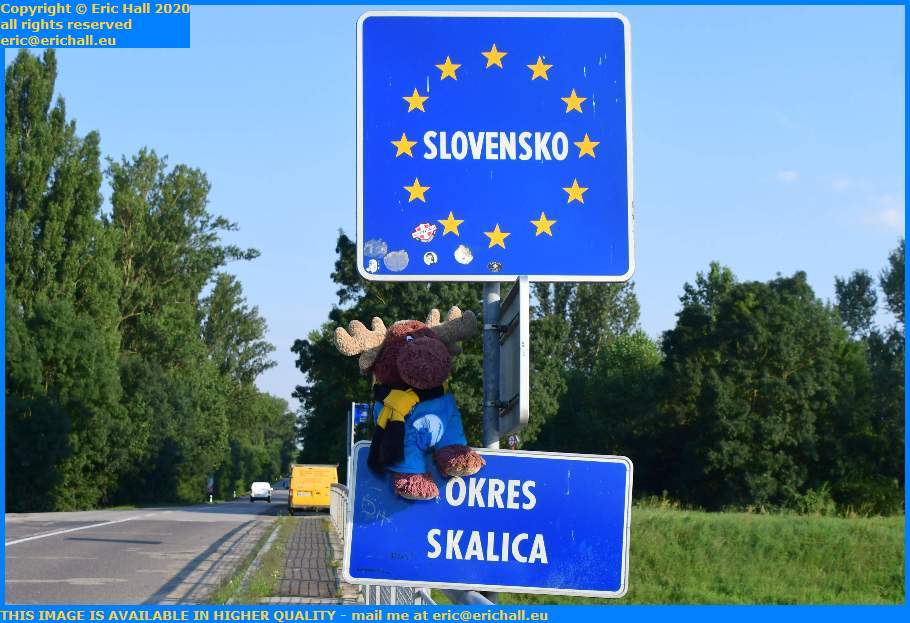 … are breaking new ground today. And here is the obligatory photo of Strawberry Moose and Caliburn, to prove that they were here. We mustn’t go forgetting that.
… are breaking new ground today. And here is the obligatory photo of Strawberry Moose and Caliburn, to prove that they were here. We mustn’t go forgetting that.
As for me, it’s 28 years and more since I last set foot in Slovakia – one of the very last coach trips that I did for Shearings back in 1992 before I left and I’m glad to be back because I happen to like Slovakia very much, despite the reputation that it has in certain quarters.
This morning I was awake at something resembling a normal working day. I’d heard all of the alarms go off and I managed to haul myself out of bed by about 06:30 – the first time for ages.
There was plenty of work to be done, such as listening to where I’d been during the night. I was going somewhere, driving and I was in Caliburn, I think. I was being followed by an old Morgan 3-wheeler with a couple in it, driven by a guy with a red handlebar moustache. They were piled up with luggage and seemed to be following me throughout all of my route across Central Europe and it was very interesting although I didn’t exchange a single word with them or anything like that and it was very intriguing to try to work out exactly what they were doing
Not just that but everything else delayed me to such an extent that I was rather late going down to breakfast. But afterwards, I came back here to pack and headed down to pay for my stay. It’s refreshing, the politeness in Eastern Europe. The guy at reception called me “sir” even AFTER I’d paid the bill.
Back outside I headed off south-east. 414 kms in the sweltering heat, roadworks and diversions everywhere.
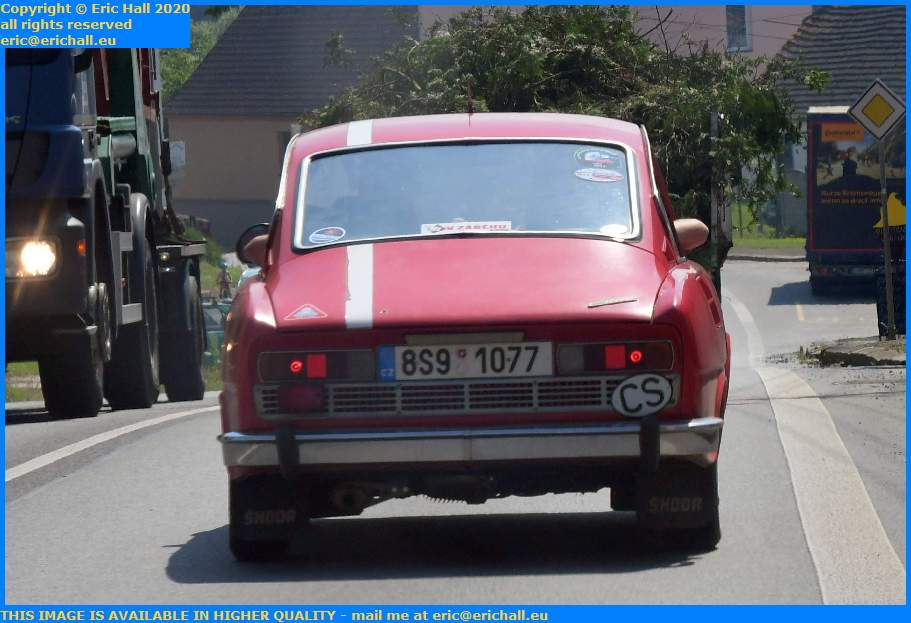 But after I’d been driving for an hour or so I suddenly found my self tagged on behind an old Czech car, a Skoda Estelle coupé. The “Estelle” was the name given in the Uk to a whole range of Skoda rear-engined cars produced from the mid-60s up until about 1990
But after I’d been driving for an hour or so I suddenly found my self tagged on behind an old Czech car, a Skoda Estelle coupé. The “Estelle” was the name given in the Uk to a whole range of Skoda rear-engined cars produced from the mid-60s up until about 1990
In Czechoslovakia, they were identified by their model names, starting with the Skoda 1000MB in 1964 and then passing through the Skoda 100 all the way up to the last 136. As far as I can tell from the rear lights, this one may well be a Skoda 110 from the early 1970s.
Seeing it on the road somehow restores my faith a little in Eastern Europe. One thing that I’ve noticed on my travels so far has been a total lack of Eastern Bloc vehicles and that has been causing me some not inconsiderable dismay.
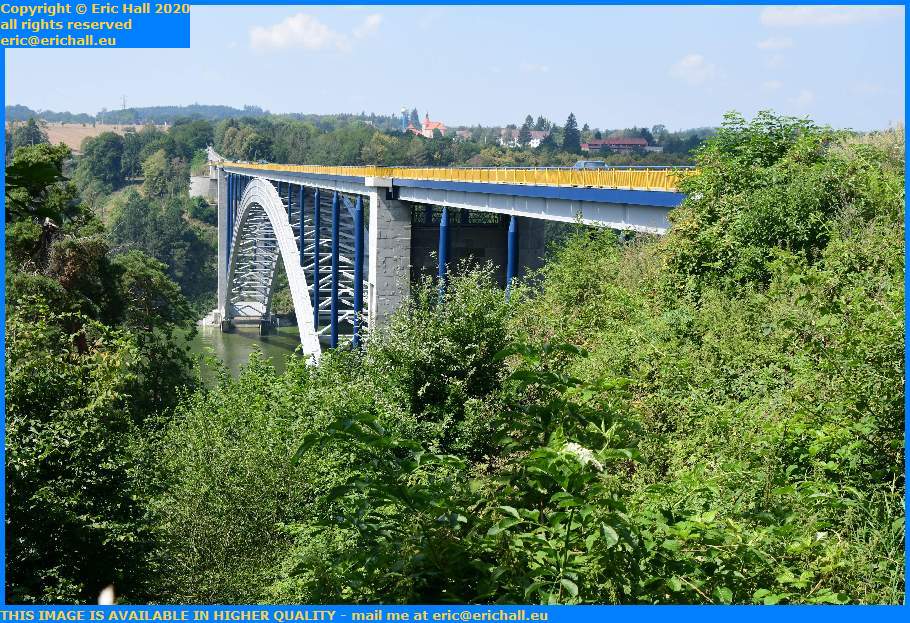 After seeing the Skoda there wasn’t very much of note or of interest until I saw this magnificent structure right in front of me. This has to be something worth a good look.
After seeing the Skoda there wasn’t very much of note or of interest until I saw this magnificent structure right in front of me. This has to be something worth a good look.
It’s called the Zdakov Bridge, built between 1957 and 1967 and has a claim to fame in that at the time of its completion the span of its arch at just marginally under 380 metres made it the longest single-arch span in the World. However it’s subsequently been surpassed by many other bridges, particularly in China
The total length of the bridge is an impressive 543 metres and it’s just under 50 metres above the water underneath it.
 The river over which it passes is the River Vltava, the longest river in the Czech Republic at 430 kilometres long.
The river over which it passes is the River Vltava, the longest river in the Czech Republic at 430 kilometres long.
This is a tributary of the Elbe and so the general flow of water is northwards-ish from its source near the southern border of the country. It’s navigable by ships of up to 1,000 tonnes as far as Prague and then by ships of 300 tonnes as far as Ceske Budejovice.
Further on, progress is impeded by the existence of various hydro-electric barrages and only very small boats can pass up and downriver beyond there.
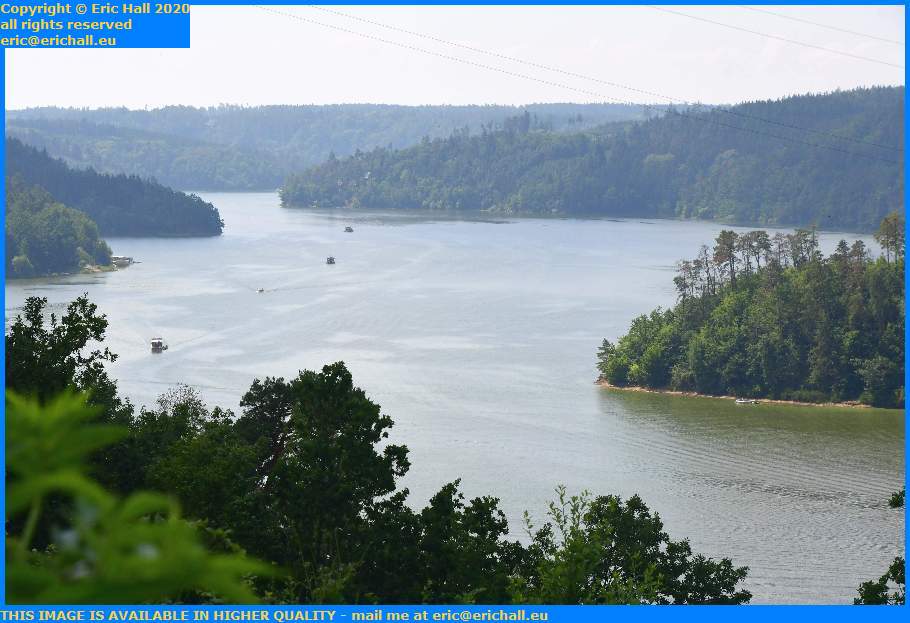 In fact, that’s one of the reasons for the bridge here because the river has been dammed here by the Orlik Dam to create the largest hydro-electric dam in the country, with power of about 360mW. You can see some of the power lines in this photo.
In fact, that’s one of the reasons for the bridge here because the river has been dammed here by the Orlik Dam to create the largest hydro-electric dam in the country, with power of about 360mW. You can see some of the power lines in this photo.
The bridge is named for the village of Zdakov which is somewhere underneath us, flooded by the lake that was created and which we can see just up there. The lake is the largest along the river by volume but not by surface area and contains 720 million cubic metres of water for a surface area of 26km².
Built between 1954 and 1961, the barrage is 91.5 metres high and 450 metres wide.
 Seeing as I needed to make a call of nature I decided to go for a walk along the river to see what might be happening here , and to stretch my legs as well.
Seeing as I needed to make a call of nature I decided to go for a walk along the river to see what might be happening here , and to stretch my legs as well.
The scenery was quite stunning and I really envied the people down there on the river cruiser that runs some kind of shuttle service along a navigable section of the river.
However, much as I would like to, I can’t spend all day sunbathing and admiring the scenery. I am running to some kind of timetable, although you may not believe it, and I have a long way to go today. The Czech republic is bigger than you think and I need to be making tracks.
And so I climbed back into Caliburn and continued on my way south-eastwards for a couple of hours.
For lunch I simply pulled up at the side of the road in the shade, had a nibble on some stuff and a little snooze for half an hour. I’m not as young as I was
 Ohhh loook what i’ve found now. Had I known that I was going to pass by here I’d have brought a potato with me and had fission chips for lunch.
Ohhh loook what i’ve found now. Had I known that I was going to pass by here I’d have brought a potato with me and had fission chips for lunch.
This is the Dukovany Nuclear Power Plant, which will be instantly recognisable to anyone who has ever played “Ton Clancy’s End War” (not that I ever have). The second Czechoslovak (and first Czech Republic) nuclear plant, built using Russian technology in the late 1970s and came on stream in the mid-80s.
There are four nuclear power units in here, all of which are in operation and three of them have been modernised in the first decade of this Century. It produces in total about 1.4TW of electricity, some of which is exported to Austria.
It’s due to be decommissioned in the mid-30s and approval in principle has been given for a replacement unit on the site
 So pushing on along my route, I eventually come to the town of Mikulov with its beautiful Romanesque Chateau.
So pushing on along my route, I eventually come to the town of Mikulov with its beautiful Romanesque Chateau.
Just a cock-stride away to my right is Austria but I’m not going that way. i’m going past one of the most important historical places in the whole of the Cezch Republic. The first written mention of the place was in 1149 and 100 years later it was in the possession of the Dukes of Liechtenstein, passing to the Hapsburg dynasty in 1560, by which time it was known as Nikolsburg.
There was a medieval stone castle situated here built before the Dukes of Liechtenstein arrived here, although the one here dates from 1719 and completed in 1730 following a fire that damaged the original. This one was burnt out by the Germans retreating from here at the end of World War II and rebuilt in the 1950s.
It’s now a museum an is said to contain one of the largest wine barrels in Europe – a mere 22,300 gallons.
Being so close to the Austrian border there was a very great Germanic influence here in the town but after the end of World War II the ethnic Germans, who made up the bulk of the population, were “removed”. The large Jewish community here had been “removed” during the War and very few survived.
 But despite being one of the major centres of Jewish life in Moravia there’s a significant Christian pilgrimage chapel here too, the Chapel of Saint Sebastian on Holy Hill at the back of town.
But despite being one of the major centres of Jewish life in Moravia there’s a significant Christian pilgrimage chapel here too, the Chapel of Saint Sebastian on Holy Hill at the back of town.
The hill itself at 1100 feet is quite significant and is a nature reserve with a load of Protected flora and fauna but the Chapel is the main attraction.
Following a plague here in 1622 the Bishop of Olomouc authorised the construction of a chapel here that would resemble St Peter’s Church in Rome. However it underwent several alterations over the years to obtain its present shape.
There were many rumours about miraculous healings associated with the site and it became a centre of pilgrimage, with accommodation being created in the town and the nearby monastery to cater for the number that arrived.
The Chapel was abandoned in 1786 under the Emperor Jospeh II’s attempts to bring the Hapsburg Empire into the modern World following the death of his traditionalist mother, but having fallen into decay, a restoration programme began in 1861.
Every year since then, except in World War II, there has been a procession of pilgrims on 8th September. They come to walk the famous “Way Of The Cross” and to see the copy of the “Black Madonna of Loreto” that is kept here.
 ontinuing on my way, dodging more and more roadworks and diversions, I crossed over into Slovakia round about 18:00.
ontinuing on my way, dodging more and more roadworks and diversions, I crossed over into Slovakia round about 18:00.
It’s the Euro in Slovakia, much to my surprise, and so with what remained of my Czech Kronor I fuelled up Caliburn at a local petrol station near the border. This brings back many memories of travelling around Europe back in the 1970s and 80s.
And then I went looking for a hotel.
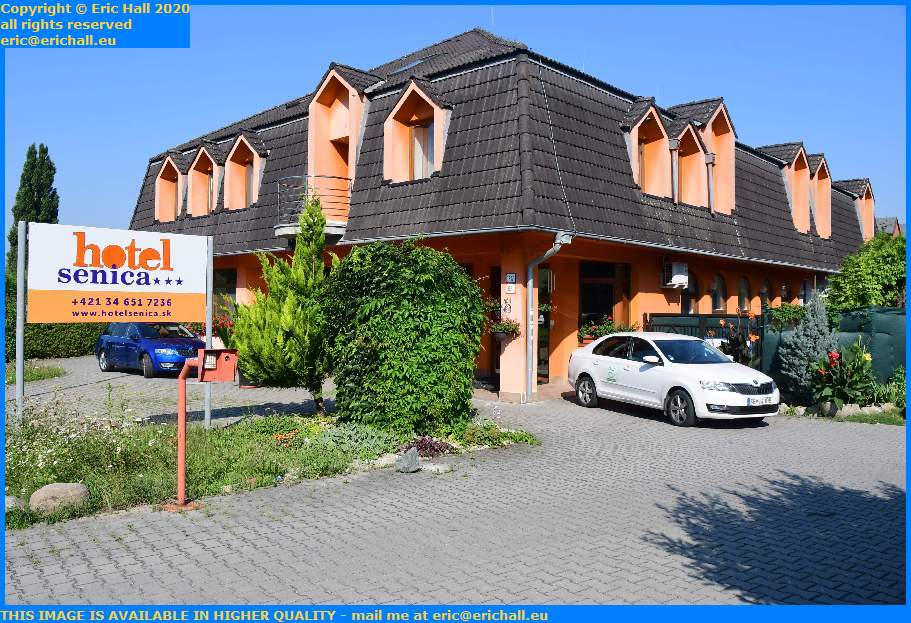 Here I am in the Hotel Senica, in the town of Senica in between the border and Bratislava.
Here I am in the Hotel Senica, in the town of Senica in between the border and Bratislava.
It’s a modern hotel on the edge of the city, very clean and tidy and, like most places in the former Eastern Europe, very good value.
First task once I’d installed myself was to set tea on the go, and then clothes-washing and a shower. It was so hot in here that after tea I crashed out again, but having worked out how the air-conditioning works, it’s a much-more reasonable temperature now.
And so I’m hoping to have a good sleep tonight and hit the road tomorrow. I’m not going to be travelling very far but nevertheless there is plenty to do.
But something else will turn up to distract me – it usually does.